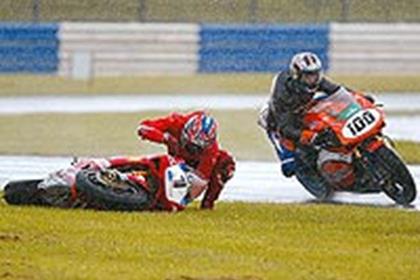2003 World Superbike regulations
The governing body that regulates the World Superbike and World Supersport series, the FIM, has introduced a series of new regulations designed principally to bring down the cost of a season’s racing.
They have reduced the number of tyres teams may use in practice and imposed stricter controls on the level of tuning permissible in Supersport.
*Tyres (Superbike): At each event, during free practices, qualifying practices and Superpole, a maximum of 13 rear slicks may be used. There is no restriction on the number of front or wet tyres that may be used.
On race day, there is no restriction on the number of rear slick tyres that may be used. If a rider is given a red flag during a Superpole lap for reasons beyond the rider’s control, the Technical Director may allow an additional rear slick tyre to be used.
*Fuel pump (Superbike): Electric fuel pumps must be wired through a circuit cut-out, which will operate automatically when the motorcycle is on its side. This circuit cut-out must de-activate the fuel pump and the ignition system within one second. The de-activation of the fuel pump and the ignition system may be checked anytime during the event at the instruction of the Technical Director.
Tyres (Supersport) – Tyres must be a fully moulded type carrying all size and sidewall marking of the tyres for commercial sale to the public. Tyres of V and Z rating must be used. The depth of the tyre treads must be at least 2.5 mm over the entire tyre pattern width at a pre-race control.
The tyres must have a positive and negative tread of 96% positive and minimum 4% negative (land and sea ratio). The maximum distance from the external edge of the tyre to 50% of the tread elements is 35 mm.
One size for the front and two sizes for the rear are allowed. Each size, front and rear, must be available with the same tread pattern as the commercial tyres for the road use. The manufacturers may only submit one front and rear pattern for approval. The previous approved tyre pattern will expire one year after the introduction of a new approved tyre pattern.
Only when a race or practice has been declared ” wet ” , the use of a special tyre commonly known as a full wet tyre is allowed.
Wet tyres must be a fully moulded tyre, no hand cutting is allowed on moulded tyres. Wet tyres do not need to carry DOT or E marks; however these tyres must be marked ” Not for Highway Use ” .
At each event, during free practices and qualifying practices, a maximum of 12 rear tyres may be used. A Technical Steward must mark these 12 tyres. There is no restriction on the number of front or wet tyres that may be used. On race day, there is no restriction on the number of rear tyres that may be used.
Cylinder Head (Supersport):The use of titanium valves are permitted for use in machines that are equipped with titanium valves in the original homologated machine.
Fuel pump (Supersport): Electric fuel pumps must be wired through a circuit cut-out, which will operate automatically when the motorcycle is on its side.
This circuit cut-out must de-activate the fuel pump and the ignition system within one second. The de-activation of the fuel pump and the ignition system may be checked anytime during the event.
Superbike Homologation: Homologation extension for 1000cc 4-cylinder motorcycles for 2003 – A manufacturer having a valid Stocksport or Superproduction homologation for a 1000cc 4-cylinder motorcycle will automatically receive a Superbike homologation for this motorcycle. This will be done by adding the motorcycle to the Superbike homologation list and informing the manufacturer.
– If the manufacturer wishes to add an optional carburetion instrument, a homologation of the optional carburetion instrument will be required.
– If no Stocksport or Superproduction homologation exists, then a new Superbike homologation will be required.


